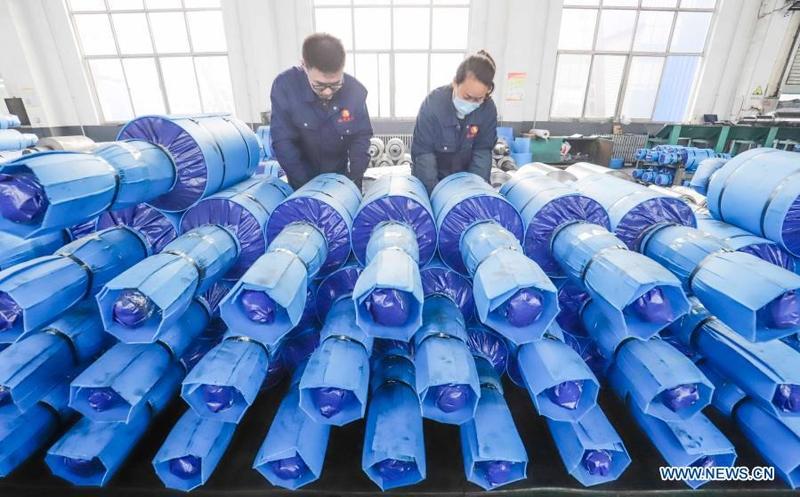 In this Nov 16, 2020 photo, workers work in a roller enterprise in Zunhua City of Tangshan, north China's Hebei province. (LIU MANCANG / XINHUA)
In this Nov 16, 2020 photo, workers work in a roller enterprise in Zunhua City of Tangshan, north China's Hebei province. (LIU MANCANG / XINHUA)
China's industrial output maintained expansion for eight straight months as factories activities keep recovering under the government's effective COVID-19 control measures.
China's value-added industrial output, an important economic indicator, went up 7 percent year-on-year in November, beating market expectations, data from the National Bureau of Statistics (NBS) showed Tuesday.
China's fixed-asset investment went up 2.6 percent year-on-year in the first 11 months of the year, 0.8 percentage points higher than the rise in the first 10 months, data from the NBS showed
The growth accelerated from a rise of 6.9 percent registered in October, according to the NBS.
On a month-on-month basis, industrial output rose 1.03 percent last month.
In the first 11 months, industrial output expanded 2.3 percent from one year earlier, 0.5 percentage points faster than the rise for the first 10 months, NBS data showed.
Among the bright spots are the equipment manufacturing and high-tech manufacturing sectors. The output of these two industries increased 11.4 percent and 10.8 percent, respectively, both markedly outpacing the overall growth in industrial output.
The industrial output is used to measure the activity of designated large enterprises with an annual business turnover of at least 20 million yuan (about US$3 million).
Tuesday's data also showed improvements in other readings of economic indicators.
ALSO READ: China's industrial output up 4.8% year-on-year in July
Fixed-asset investment up 2.6%
China's fixed-asset investment went up 2.6 percent year-on-year in the first 11 months of the year, 0.8 percentage points higher than the rise in the first 10 months, data from the NBS showed.
On a month-on-month basis, the country's fixed-asset investment climbed 2.8 percent in November.
During the first 11 months, investment by the private sector rose 0.2 percent, the first growth registered this year.
The fixed-asset investment includes capital spent on infrastructure, property, machinery and other physical assets.
Retail sales up 5%
China's retail sales of consumer goods went up 5 percent year-on-year to 3.95 trillion yuan (about US$603.7 billion) in November, NBS data showed.
The growth picked up from the 4.3-percent gain in October, sustaining the upward momentum since the major consumption gauge posted its first positive growth this year in August.
Excluding auto consumption, retail sales went up 4.2 percent year-on-year last month.
In the first 11 months, retail sales went down 4.8 percent year-on-year, with the decline narrowing by 1.1 percentage points from the drop in the January-October period.
Online consumption remained a bright spot, with online retail sales rising 11.5 percent year-on-year in the January-November period.
China's consumer spending continued to gather steam in November, solidifying its role as a key growth engine amid the economic recovery, official data showed Tuesday.
Consumption in rural areas gained 5.6 percent, outpacing a rise of 4.9 percent in urban regions.
Meanwhile, a closer look at the data revealed that upgraded demand has pushed up the consumption growth, led by sales of telecommunication equipment, cosmetics and jewelry.
"As the economy gradually recovers to normalized growth, consumption will remain a major engine underpinning the economic growth," NBS spokesperson Fu Linghui noted.
Commercial housing sales in terms of floor area totaled 1.51 billion square meters in the first 11 months, up 1.3 percent from a year ago
Property investment up 6.8%
China's investment in property development rose 6.8 percent year-on-year in the first 11 months, picking up from the 6.3-percent increase in the first 10 months, NBS data showed.
Commercial housing sales in terms of floor area totaled 1.51 billion square meters in the first 11 months, up 1.3 percent from a year ago.
In terms of value, commercial housing sales jumped 7.2 percent year-on-year to 14.9 trillion yuan (about US$2.28 trillion) in the first 11 months, widening from the 5.8-percent increase in the first 10 months.
Urban unemployment rate drops
China's surveyed urban unemployment rate stood at 5.2 percent in November, 0.1 percentage points lower than that of October, data from NBS data showed.
The unemployment rate has dropped for four months in a row, as the Chinese economy continues to strengthen its recovery from the COVID-19 slump.
A total of 10.99 million new urban jobs were created in the first 11 months, completing 122.1 percent of the target set for the whole year, said the NBS.
The surveyed unemployment rate among those aged between 25 and 59, the majority of the labor market, stood at 4.7 percent last month, down 0.1 percentage points.
Meanwhile, the surveyed unemployment rate in 31 major cities was 5.2 percent last month, which was also down 0.1 percentage points from October, according to the NBS.
READ MORE: China's industrial robot output surges 29.2%
The surveyed urban unemployment rate is calculated based on the number of unemployed people who have participated in the employment survey in urban areas.
China has given priority to stabilizing employment and ensuring living standards this year. This year's government work report set targets for adding over 9 million new urban jobs and keeping the surveyed urban unemployment rate at around 6 percent.


